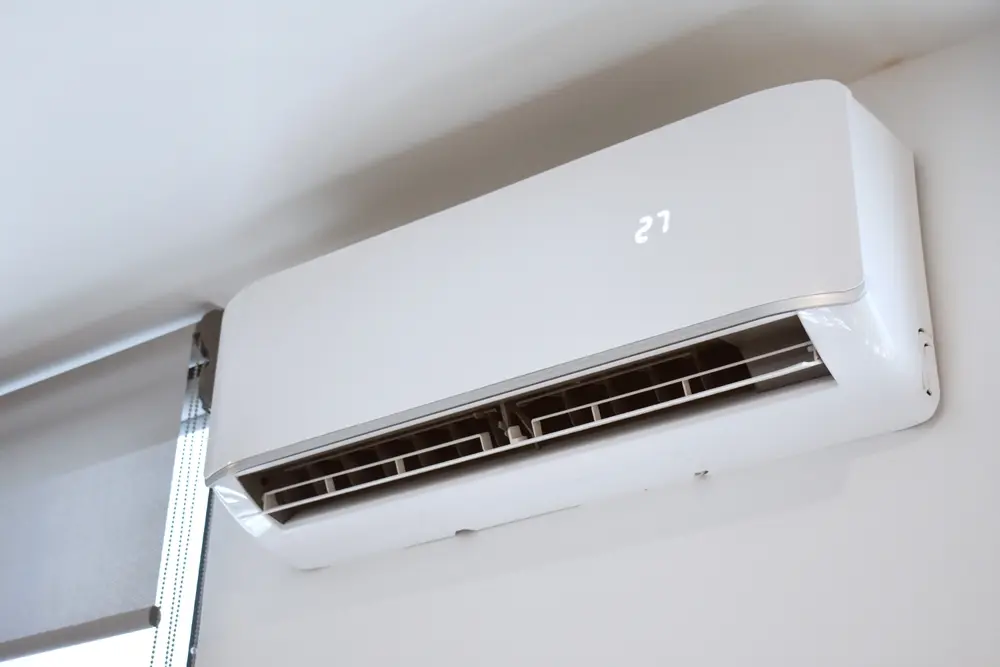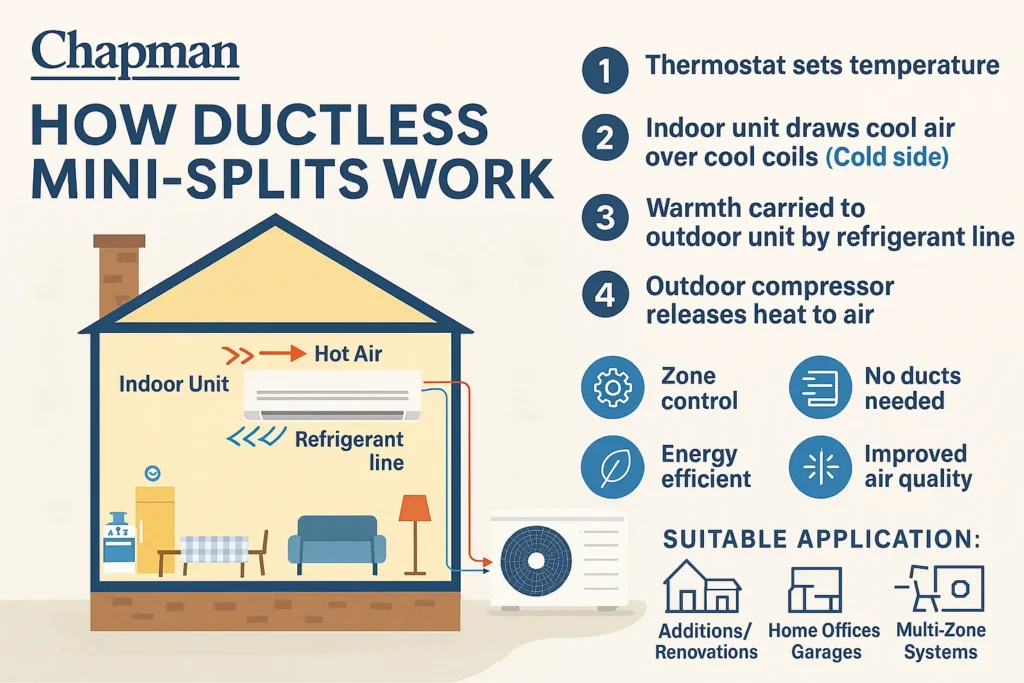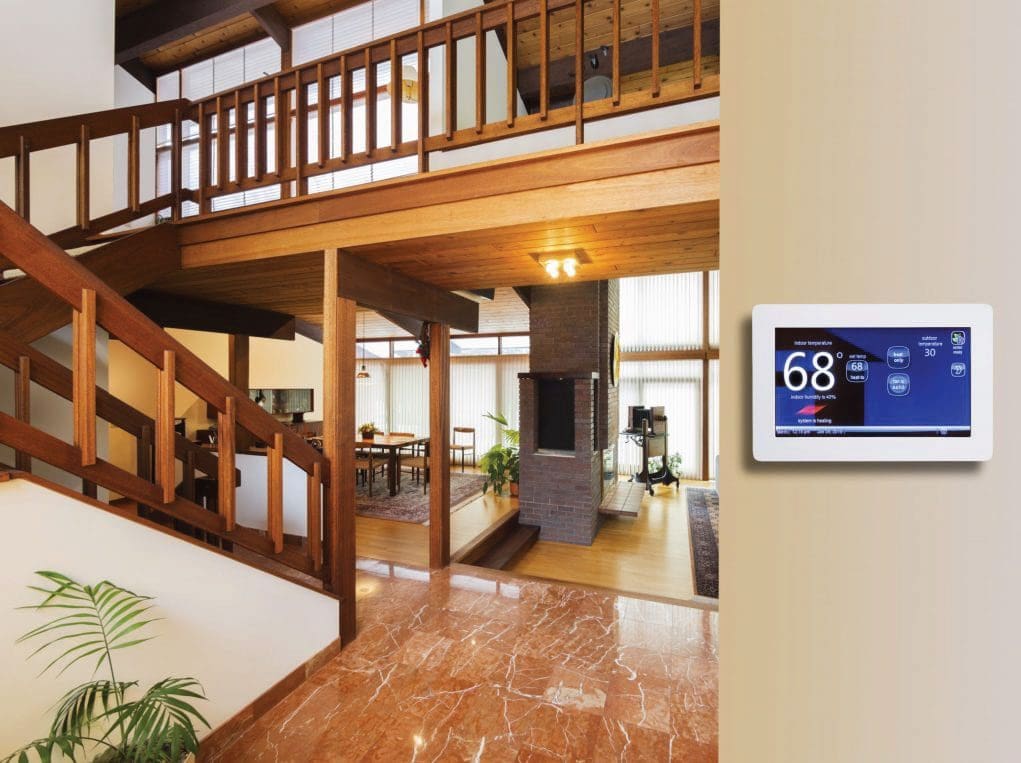
Blog
What is a Ductless Mini-Split? A Simple Guide for Homeowners

Ductless mini-splits have become a bit of a hot topic—and for a good reason. But what is a ductless mini-split, and why are so many homeowners making the switch?
This guide will walk you through how a mini-split system works, its pros and cons, and how to determine if one is right for your space.
Key Components of Mini-Split Systems
Ductless mini-split systems are popular for their energy efficiency, zone-based comfort, and ease of installation. Plus, they’re great for homes without existing ductwork.
Mini-splits rely on a few essential components that work together to heat or cool your space:
Outdoor and Indoor Units
- Compressor/Condensor Unit (Outside): Located outside the home, the compressor is responsible for circulating refrigerant between the indoor and outdoor units.
- Air Handler Unit/Evaporator (Inside): The indoor unit is mounted on a wall, ceiling, or floor. It pulls in warm air from the room, passes it over cold evaporator coils, and blows the cooled air back into the space.
Conduit
The outdoor and indoor units are connected by a small conduit that runs through a 3-inch hole in the wall. This conduit houses the power cables, refrigerant tubing, and condensate drain line.
Here's How They Work
Mini-splits use the refrigeration cycle to move heat rather than generate it, making them incredibly efficient. They transfer heat between the air inside and the refrigerant inside the indoor unit to the outdoor unit, which is where the refrigerant is compressed and circulated back into the indoor unit.
It’s a continuous cycle that helps keep your home at a comfortable temperature. Mini-splits are also great for homes with limited space, as they are typically mounted high on an indoor wall or at floor level.
Understanding the Different Types of Mini-Split Systems
There’s no one-size-fits-all mini-split. Below are several types of mini-splits that you should familiarize yourself with.
Ductless Air Conditioner
A mini-split air conditioner is designed for homeowners who already have a heating system but want to add high-efficiency cooling. These are much more powerful than window units.
Ductless Heat Pumps
A mini split heat pump is a dual-operating system that heats and cools your home. It’s a great solution for homeowners without non-ducted heating systems, such as radiant panels and space heaters.
Single-Zone Systems
These systems pair one outdoor unit with one indoor unit. They’re ideal for individual rooms and small apartments. They’re also great for those on a budget.
Multi-Zone Systems
Multi-zone mini splits can connect up to five indoor units to a single outdoor compressor. Each unit has its own remote, so you can independently control temperatures in different rooms.

Advantages of Ductless HVAC Systems
Homeowners are increasingly turning to ductless HVAC systems for their flexibility and modern design. Here’s why they’re a great option for many households:
Zoned Heating and Cooling
Ductless systems are small and flexible. Each indoor unit operates independently, letting you heat or cool rooms only when in use, saving energy and improving your comfort by preventing temperature imbalances.
Simple Installation
Compared to central systems, mini-splits don’t require ducts, making them easier and less expensive to install. They only need a small wall penetration for the conduit.
Energy Efficient
Since mini-splits don’t use air ducts, there’s no need to worry about leaks and energy waste. In fact, ENERGY STAR–certified models meet strict guidelines for energy savings and performance.
Quiet Operation
Mini-split systems are known for being super quiet. You will likely hear the air handler when the system is on, but the noise is far quieter than a central HVAC system.
Disadvantages of Ductless HVAC Systems
While ductless mini-splits offer many advantages, they aren’t perfect for everyone. Here are a few downsides to consider before making a decision:
Higher Cost
The initial cost of mini-split systems can be higher than some traditional HVAC solutions, including window units. Though you may save on energy bills long-term, the upfront investment may be a hurdle for some.
Sizing
Mini-split systems need to be correctly sized for each space. If the system is too small, it won’t keep up with your comfort needs. Too large, and it may cycle on and off too frequently, wasting energy and reducing lifespan.
Aesthetic Concerns
Unlike central air vents, ductless indoor units are visible on walls or ceilings. While they’re sleek and compact, some homeowners may find them less visually appealing.
Lower Air Filtration
Although many mini-splits have built-in filters, they typically don’t match the air-cleaning capabilities of full HVAC systems with advanced filtration or UV options. This can be a concern for households with allergies, pets, or high indoor air quality needs.

Is a Ductless Mini-Split Right for Your Home?
It might be! Mini-splits can be a smart solution for supplementing areas where traditional HVAC struggles.
Consider the following:
- You live in an older home without ductwork - If you live in an older home, then you likely do not have ductwork. Avoid costly renovations by using a mini-split instead of retrofitting ducts.
- You rely on costly electric baseboard or wall heaters - A mini-split heat pump is often far more efficient and provides cooling too, making it an excellent year-round investment.
- You’re adding a room or remodeling - Home additions, in-law suites, or finished basements often lack ductwork. Mini-splits provide targeted comfort without overloading your current system.
- You want improved climate control - Mini-splits offer better climate control capabilities for areas like sunrooms, enclosed patios, finished attics, workshops, or garages.
Let Us Help You Find the Perfect Heating and Cooling Solution
Ductless mini-split systems provide flexible comfort, high energy efficiency, and personalized control, making them an excellent choice for many modern households. But as you probably know, every home is unique, and selecting the right system depends on your space, layout, and comfort needs.
Whether you’re considering a ductless air conditioner, a zone control system, or complete air conditioning replacement, our experienced team is here to help.
With over 40 years of HVAC experience, we’ve helped thousands of Indiana homeowners find efficient, modern solutions tailored to their needs. Contact us today to explore your options and schedule a free consultation.









